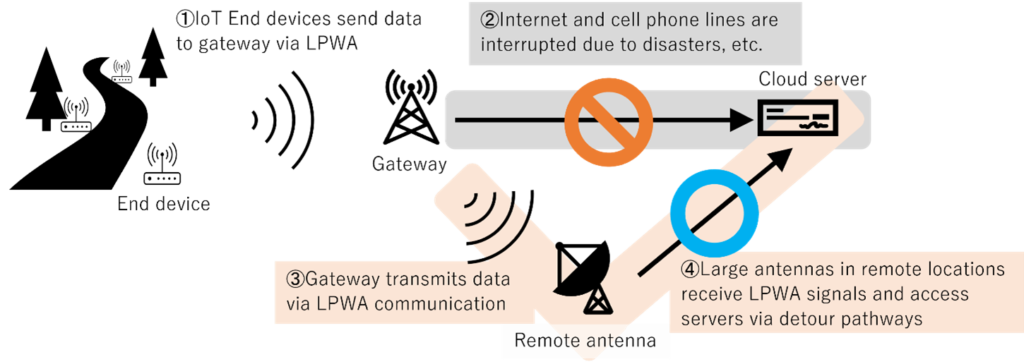Advantages
- Proposes a way of communication for IoT systems that can operate stably even in times of disaster.
- Low cost of implementation: Hardware requires minor or no modification, can be implemented with software changes.
Technology Overview & Background
An IoT system consists of “end devices,” which are sensing terminals, “gateways,” which are servers that collect data from the end devices, and “cloud servers,” which aggregate, store, and process data from the gateways. End-devices and gateways are connected via wireless communications, such as LPWA (Low Power Wide Area). On the other hand, the Internet or leased lines are used to connect the gateway to the cloud server, but if the lines become disconnected or congested due to a natural disaster, the entire IoT system may become unusable.
To solve this problem, Associate Professor Toshihiro Kameda, affiliated with the University of Tsukuba’s Department of Systems and Information Sciences, has developed a new communication system. The figure below shows a river flow sensor as an example. The end device and gateway are connected by LPWA ( <1> in the figure), and the gateway is connected to a cloud server via the Internet or other means (<2> in the figure). If the connection between the gateway and the cloud is disrupted by an earthquake or flood, the gateway stops communicating through the normal path and starts “transmitting” from its own LPWA antenna (<3>). The LPWA signal transmitted by the gateway is then received by a large receiving antenna “remote receiving station” located in a remote area, and the data finally reaches the cloud server (<4>). The key to this technology is that this large antenna, which is located in a remote area and is not affected by natural disasters, can receive LPWA signals with weak output at the remote location. Note that this remote receiving station is considered to have sufficient capability even in a portable size, such as in an automobile.
The cost of implementing this technology is expected to be low. Adding a transmitting function to the gateway’s LPWA receiver would be possible with minor hardware design changes and software modifications. It would also be possible to share the remote receiving station with other communication facilities.
 |
Patents & Publications
Applied in Japan. Planed PCT application.
Principal Investigator & Academic Institution
Toshihiro Kameda (Associate Professor, University of Tsukuba)
Expectations
The University of Tsukuba is looking for companies interested in commercializing IoT systems based on this technology. By signing a nondisclosure agreement with the University of Tsukuba, we can disclose technical details. We can also consult with you on joint research to develop the technology in collaboration with the university. Furthermore, the university can license the patent to the company.
Project No. DA-04744


